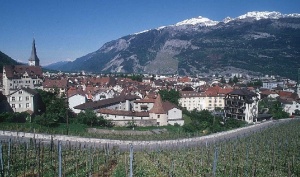Chur
(pronounced: "Khoor") This beautiful old city in the southeastern part of Switzerland (see its Wikipedia listing for more information) is one of the oldest continuously inhabited places in Europe. Chur's initial settlement happened in the Neolithic period, around 2500 BC, on the left side of the river Plessur: the remnants of Bronze Age, Iron Age and Roman1 buildings can still be found in the ancient settlement-area, now known as Welschdörfli, the "strangers' town".
Some of the visitors in that ancient past would have seemed more than usually strange, as Chur became one of Europe's first "managed" worldgate sites. The management at first came from outside; when local population pressure rose high enough to equal the local value of the threshold constant and the first worldgate manifested itself in the Welschdörfli area, it was detected by the ancient Interconnect Project based on Alterf IVa / lambda Leonis IVa. The Project operators—surprised at the power and reach of so new and remote a gate—sent a Demisiv translocation manager to Welschdörfli, thus probably giving rise to some of the stories about the ancient Celts worshipping trees. This management role was passed to the Interconnect Project management redistribution team at Rirhath B some two millennia later, subsequent to the collapse of Alterf.
One other gate spontaneously appeared during the 1400's in the neighborhood of the Calanda mountain north of Chur, and was the cause of many early stories suggesting that the mountain was haunted. This gate was later relocated to the neighborhood of Chur SBB, the Swiss National Railways station north of Chur's old town. It was once again relocated in the 1990's to accomodate the first stage of the track reorganization there, and the construction of the new regional postbus facility. Another worldgate relocation was required during April 2007 in anticipation of the summer opening of the refurbished / expanded Chur SBB station facilities. (Click here for a panoramic view of the station during recent construction)
Because of the surprising power of the two worldgates, they still attract high levels of traffic both from Europe-based wizards doing on-Earth transits, and wizards located elsewhere on Earth who want to avoid the peak traffic levels at intercontinual gate facilities like Grand Central Terminal. At the Crossings, as a "legacy destination", Chur has a dedicated gate cluster in the Main Concourse (hexes 330-340). And in Switzerland, Calanda is now just a really great brand of beer. (TBONWM et seq.)
(See also: Samnaun.)
1The city's present name is derived initially from an ancient Celtic word, kora or koria, "tribe", and later from Curia Rhaetiae, "the Courts of the Raetians" (the Raetii were the local Celtic tribe, mentioned by Julius Caesar in his writings).

